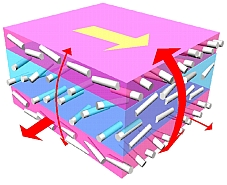Features
Capabilties
Different applications utilize one or a combination of the features listed below:

- Nonlinear dynamics
- Parallel processing (SMP, MPP)
- Rigid body dynamics
- Quasi-static simulations
- Normal modes
- Linear statics
- Thermal analysis
- Fluid analysis (Euler, ALE)
- Failure analysis
- Underwater shock
- Crack propagation
- Real-time acoustics
- Earthquake ground motion
- Design optimization
- Implicit springback
- Multiphysics coupling (structural, thermal, fluid, acoustic, etc.)
- Structural-thermal coupling
- SPH (Smooth Particle Hydrodynamics)
- EFG (Element Free Galerkin)
- BEM (Boundary Element Method)
- Fully automated contact analysis
- Function input (FORTRAN or C syntax)
- Encryption of material input data
- Redundant network license server
- Electromagnetic simulation (v980)
A variety of controls, options, and subroutines permit the user to have maximum flexibility in defining the simulation problems:

- Keyword input
- Global/ selective mass scaling
- Explicit und implicit time integration
- Adaptive remeshing
- Direct input of Nastran bulk data files
- Splitting of input file into subfiles
- User subroutines
- Re-mapping
- Transmitting boundaries
- Dynamic storage allocation
- Extensive output data controls (ascii/ binary)
- Sense switch controls - monitor simulations status
- Dynamic relaxation
- Interactive real-time graphics
- Pre-stressing from Nastran Linear Solution'
- Double Precision
Element library
LS-DYNA has an extensive element library with both under-integrated and fully-integrated element formulations.

- Lumped inertias/masses
- Beams
- Hughes-Liu beam
- Belytschko-Schwer resultant beam
- Truss element
- Belytschko-Schwer beam with full cross-section integration
- Belytschko-Schwer tubular beam
- Discrete beam / cable
- 2D Plane strain shell element
- 2D Axisymmetric volume weighted shell element
- Spotweld beam
- Discrete elements
- Spring (translational and torsional)
- Damper (translational and torsional)
- Solids
- 8-Node brick element
- 4-Node tetrahedron element
- Arbitrary Lagrangian-Eulerian (ALE) brick element
- Eulerian brick element
- Eulerian Navier-Stokes element
- 8-Node thick shells
- Reduced integration
- Selective reduced integration
- 4-Node thin shells
- Hughes-Liu shell
- Belytschko-Tsay shell
- Belytschko-Leviathan shell
- Belytschko-Wong-Chiang shell
- Fully Integrated shells
- Plane Stress shell
- Plane Strain shell
- Triangular shells
- C0 shell
- DKT shell
- Membranes
- Belytschko-Tsay membranes
- Fully Integrated Belytschko-Tsay membrane
- Seatbelt elements
- Pretensioner
- Retractor
- Slipring
- Sensor, accelerometer
- SPH elements
- Spotwelds
Material models
LS-DYNA provides more than 130 metallic and non-metallic material models.

- Elastic
- Metals
- Plastics
- Linear visco-elasticity
- Elasto-viscoplastic
- Elastomers and rubbers
- Glass models
- Foams
- Fabrics
- Composites
- Honeycombs
- Kevlar material with damage
- Equations-of-state hydrodynamic models
- Acoustic pressure material/element
- Concrete & soils
- High explosives
- Propellants
- Viscous fluids
- Biomechanic material models
- Failure models
- User-defined materials
Contact options
The fully automated contact analysis capability in LS-DYNA is easy to use, robust, and validated. It uses constraint and penalty methods to satisfy contact conditions. These techniques have worked extremely well over the past twenty years in numerous applications such as full-car crashworthiness studies, system/component analysis, and occupant safety analysis. Coupled thermo-mechanical contact can also be handled. Over 40 different contacts are available. Multiple contact options are possible, for example:

- Single surface contact
- Contact with rigid walls
- Beam-beam contact
- Tied surfaces
- Nodes tied to surfaces
- Shell edges tied to shell surfaces
- Fluid-structure interfaces
- Eroding contact
- Edge-to-edge contact
- Resultant force contact
- Draw beads
- Pinball contact
- Flexible body contact
- Flexible body to rigid body contact
- Rigid body to rigid body contact
- Sliding contact
- Contact with CAD surfaces
- Heat transfer across the contact surface
- User-defined contact options
A special option exists for treating contact between a rigid surface (usually defined as an analytical surface) and a deformable structure. On example is in metal forming, where the punch and die surface geometries can be input as IGES- or VDA-surfaces which are assumed rigid. Another example is in occupant modeling, where the rigid-body occupant dummy (made up of geometric surfaces) contacts deformable structures such as airbags and instrument panels.
Several friction models are available:
- Static and dynamic Coulomb friction
- Viscous friction
- Pressure dependent friction
- User-defined friction models
Contact input is made easier by allowing contact to be defined by part identifiers, by box, or by simply including the entire model in the contact definition.
Specialized automotive features

- Seat-belts - including modeling of accelerometer, pretensioner, retractor, sensor, and slip ring
- Inflator models
- Airbag fabric constitutive models
- Accelerometers
- Airbag sensors
- Airbag breakout
- Eulerian deployment of airbags
- Airbag folder
- Unfolded reference geometry for airbags
- Dummy positioner
- Side-impact dummy special damper
- Particle method (Corpuskular) for airbag deployment
Specialized metal forming features

- Anisotropic Strain Rate Dependent Plasticity
- Static condensation (elastic tool deformations)
- 'One-Step' solution
- Rigid tooling
- Specific contact options
- Thermal contact
- Automatic segment orientation
- Coupled thermal/mechanical analysis
- Multi stage tooling
- Implicit springback
- Trimming (shell elements only)
- ALE formulation (Arbitrary Lagrangian-Eulerian)
- Adaptive mesh refinement
- Element deletion due to element failure
- 'Rigid Body Stoppers' for tool control
- 'Strain-rate speed up' for superplastic forming
- Pressure via Load Mask (Hydroforming)
Adaptivity
Automatic re-meshing permits the user to achieve accurate results at minimum cost:
- Adaptive options
- Error norms
- User-specified refinement levels
- Sub-cycling
- Graphical output
Rigid body dynamics

- Spherical and revolute joints
- Cylindrical
- Planar
- Universal
- Translational
- Locking
- Translational and rotational motor
- Gear
- Rack and pinion
- Pulley
- Screw
- Cardan joint
- Switching rigid to deformable material
- Rigid body stoppers
- Rigid body contact